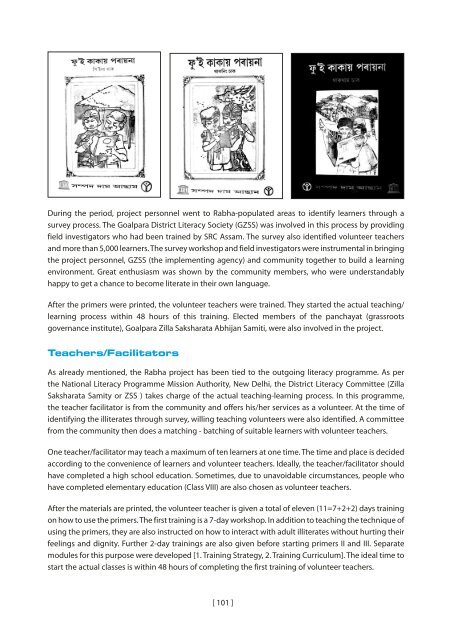Mother Tongue-based Literacy Programmes: Case Studies of Good ...
Mother Tongue-based Literacy Programmes: Case Studies of Good ...
Mother Tongue-based Literacy Programmes: Case Studies of Good ...
You also want an ePaper? Increase the reach of your titles
YUMPU automatically turns print PDFs into web optimized ePapers that Google loves.
During the period, project personnel went to Rabha-populated areas to identify learners through asurvey process. The Goalpara District <strong>Literacy</strong> Society (GZSS) was involved in this process by providingfield investigators who had been trained by SRC Assam. The survey also identified volunteer teachersand more than 5,000 learners. The survey workshop and field investigators were instrumental in bringingthe project personnel, GZSS (the implementing agency) and community together to build a learningenvironment. Great enthusiasm was shown by the community members, who were understandablyhappy to get a chance to become literate in their own language.After the primers were printed, the volunteer teachers were trained. They started the actual teaching/learning process within 48 hours <strong>of</strong> this training. Elected members <strong>of</strong> the panchayat (grassrootsgovernance institute), Goalpara Zilla Saksharata Abhijan Samiti, were also involved in the project.Teachers/FacilitatorsAs already mentioned, the Rabha project has been tied to the outgoing literacy programme. As perthe National <strong>Literacy</strong> Programme Mission Authority, New Delhi, the District <strong>Literacy</strong> Committee (ZillaSaksharata Samity or ZSS ) takes charge <strong>of</strong> the actual teaching-learning process. In this programme,the teacher facilitator is from the community and <strong>of</strong>fers his/her services as a volunteer. At the time <strong>of</strong>identifying the illiterates through survey, willing teaching volunteers were also identified. A committeefrom the community then does a matching - batching <strong>of</strong> suitable learners with volunteer teachers.One teacher/facilitator may teach a maximum <strong>of</strong> ten learners at one time. The time and place is decidedaccording to the convenience <strong>of</strong> learners and volunteer teachers. Ideally, the teacher/facilitator shouldhave completed a high school education. Sometimes, due to unavoidable circumstances, people whohave completed elementary education (Class VIII) are also chosen as volunteer teachers.After the materials are printed, the volunteer teacher is given a total <strong>of</strong> eleven (11=7+2+2) days trainingon how to use the primers. The first training is a 7-day workshop. In addition to teaching the technique <strong>of</strong>using the primers, they are also instructed on how to interact with adult illiterates without hurting theirfeelings and dignity. Further 2-day trainings are also given before starting primers II and III. Separatemodules for this purpose were developed [1. Training Strategy, 2. Training Curriculum]. The ideal time tostart the actual classes is within 48 hours <strong>of</strong> completing the first training <strong>of</strong> volunteer teachers.[ 101 ]

















